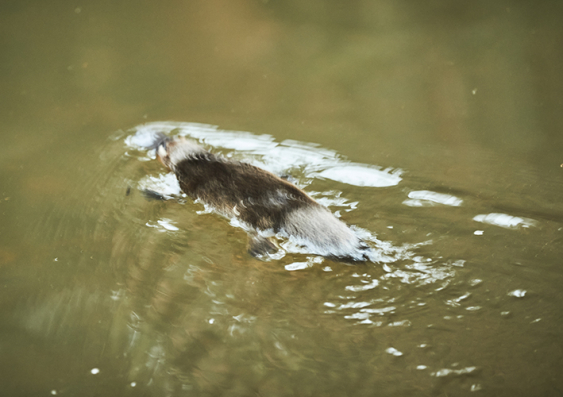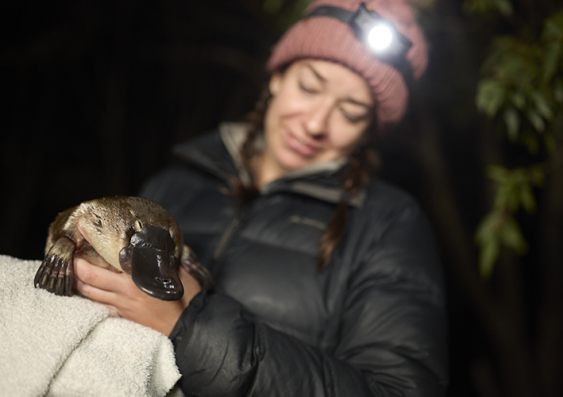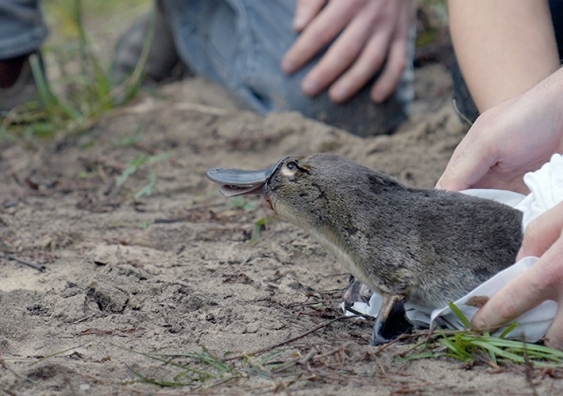More platypuses join thriving Royal National Park population, following new funding support
2025-06-06T09:00:00+10:00

Tahneal Hawke releases a platypus captured as part of the project to repopulate Royal National Park.
Photo: Â鶹Éçmadou Sydney/Richard Freeman
Â鶹Éçmadou Sydney’s Platypus Conservation Initiative has expanded its landmark program to restore species in the wild.
Two years after the historic return of platypuses to Royal National Park, researchers from Â鶹Éçmadou Sydney have launched the second phase of this landmark conservation program, with the introduction of three more platypuses to the Hacking River in the Royal National Park.
The three are part of a planned 10 new platypuses that will be reintroduced to the Royal National Park over the next three years, with the aim to strengthen genetic diversity and support a thriving, long-term population.
The founding population introduced in 2023 has exceeded expectations, with at least nine of the 10 animals confirmed to have survived the critical first year. And with breeding occurring earlier than anticipated, there is strong evidence that a self-sustaining population is already taking shape.
“This is a deeply moving affirmation of what targeted conservation can achieve,” says Dr Gilad Bino, lead researcher from the Centre for Ecosystem Science at Â鶹Éçmadou Sydney. “To now see them surviving, breeding, and reclaiming this landscape is extraordinary. It’s not just a scientific success – it’s a restoration of what was lost.”
Â鶹Éçmadou researchers embarked on the next phase of the project following a $630,000 funding boost over the next three years from Peabody’s Metropolitan Mine. The staged reintroduction over three years will continue to prioritise genetic diversity, supported by intensive monitoring and adaptive management.
“This funding strengthens our ability to continue this important work and reflects a shared commitment to restoring a healthy and diverse platypus population in Royal National Park,” Dr Bino said.
The Royal National Park platypus reintroduction is the first of its kind in New South Wales and among the most ambitious wildlife recovery projects undertaken in the state. It was grounded in rigorous planning, risk assessments, and strong community collaboration to ensure the animals’ welfare and the suitability of their new habitat.
Researchers from Â鶹Éçmadou’s Platypus Conservation Initiative have been tracking the animals’ movements and behaviour using remote monitoring and live trapping. These tools have delivered rare insight into how platypuses explore, settle, and interact with their environment – informing future conservation strategies.
Ěý
The data we collect now will shape the future of platypus conservation – not just in Royal National Park, but across their entire range.
During phase one, the team collaborated closely with local land managers, community groups, and volunteers to monitor river health and address threats such as invasive species and pollution. Essential support and on-ground collaboration from the NSW National Parks and Wildlife Service played a vital role –from access and logistics to long-term habitat protection and planning. It is hoped that this partnership will continue throughout phase two and beyond.
“Each reintroduction gives us a chance to learn more about how platypuses adapt, move, and behave in restored environments,” says Dr Tahneal Hawke, researcher at the Centre for Ecosystem Science. “The data we collect now will shape the future of platypus conservation – not just in Royal National Park, but across their entire range.”
Professor Richard Kingsford, Director of the Centre for Ecosystem Science, says the project demonstrates the power of collaborative conservation.
“It’s a blueprint for how science, government, industry, and the community can work together to restore ecosystems and safeguard our most iconic wildlife,” he says.
James Hannigan, General Manager of Peabody’s Metropolitan Mine, says the company is proud to support local conservation efforts.Ěý
“This is a rare opportunity to help return and ensure the long-term viability of an iconic species to its natural home. We’re pleased to play a role in this initiative and commend the work of Â鶹Éçmadou in delivering this meaningful outcome for the Royal National Park and the Helensburgh community where we operate.”Ěý
As the project enters its next phase, Â鶹Éçmadou’s Platypus Conservation Initiative remains at the forefront of efforts to conserve this extraordinary species, including returning it to its rightful place in the wild.








